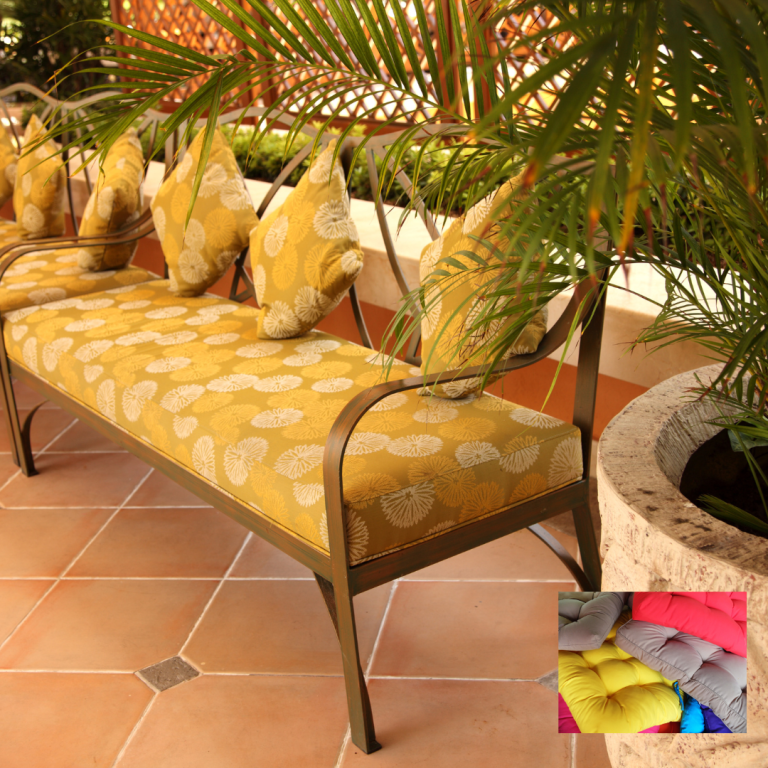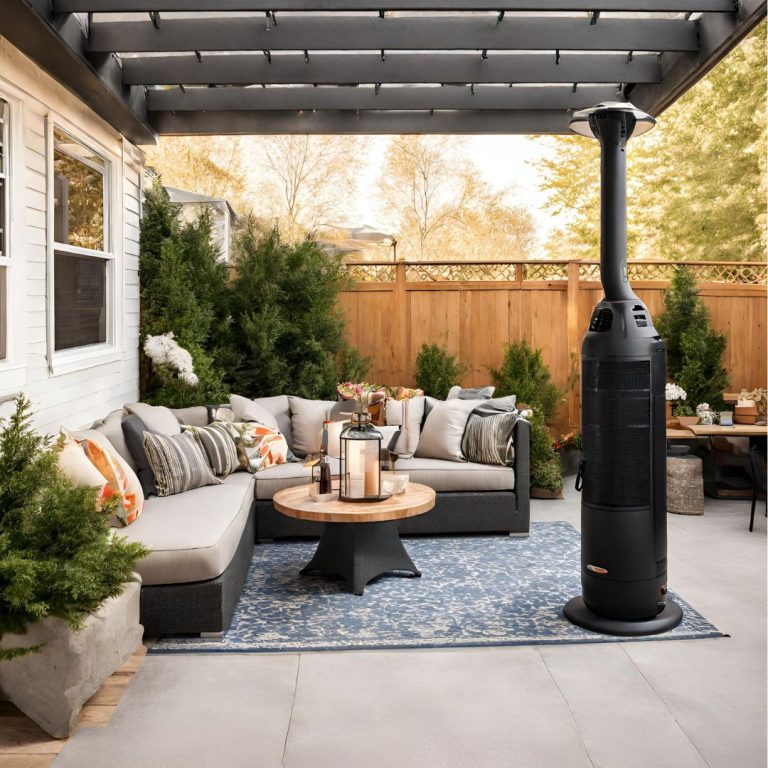Patio Privacy Ideas
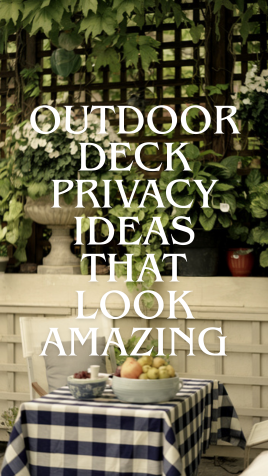
21 Patio Privacy Ideas: The Secret’s Out On Stylish Deck & Patio Solutions You’ll Love
Spending time outdoors feels more enjoyable when you can relax without distractions. Whether you host friends, share meals, or simply unwind, privacy helps create a comfortable and stylish space that feels like an extension of your home. Adding the right privacy solutions lets you enjoy your patio, deck, or balcony with ease while enhancing the overall look of your outdoor area.
You don’t need a large yard or a big budget to make it happen. From natural plant walls to clever DIY builds and sleek modern designs, you have plenty of options that balance function and style. This guide explores 21 creative ways to give your outdoor space the privacy it needs while keeping it inviting and versatile.
Living Green Solutions
Using plants as natural barriers gives you privacy while keeping your patio space fresh and inviting. Green solutions work well because they blend into the landscape and soften the look of fences or walls.
You can plant hedges like boxwood, privet, or arborvitae to create a tall, dense screen. These options stay green year-round and give you a consistent level of coverage.
For faster results, consider bamboo. It grows quickly, forms a lush wall, and requires little maintenance once established. Just make sure to choose clumping varieties to prevent spreading.
Climbing plants on a trellis or pergola add both shade and seclusion. Vines like ivy, jasmine, or clematis can cover structures within a season and bring color and texture to your patio.
A simple option is using potted plants. Large planters with tall grasses, small trees, or shrubs can be moved around to adjust your privacy needs. This works well for patios with limited space.
| Plant Type | Best Feature | Care Level |
|---|---|---|
| Hedges | Dense, year-round cover | Moderate |
| Bamboo | Fast-growing, tall | Low |
| Climbing Vines | Decorative, flexible | Moderate |
| Potted Plants | Portable, versatile | Low |
Adding greenery not only improves privacy but also reduces noise and creates a more relaxing atmosphere. You can mix different plant types for a layered effect that feels natural and balanced.
Living Bamboo Wall
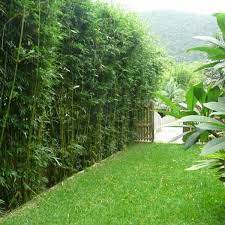
You can use tall bamboo planters to build a natural wall that screens your patio or deck. The height and density of bamboo create an effective barrier without the need for heavy structures. This setup works well in small or large spaces.
Bamboo grows quickly, so you don’t have to wait long for coverage. Once established, it fills in with thick greenery that softens the look of hard surfaces. Choosing clumping varieties helps you control growth and keep the wall neat.
The plants also provide a calming backdrop. Their leaves move gently with the wind, adding a natural element to your outdoor space. This makes your seating area feel more private and comfortable.
A living bamboo wall can reduce noise as well. The dense stems and foliage help absorb and block sound, giving you a quieter setting. This is useful if you live near a street or close to neighbors.
Using planters instead of planting directly in the ground gives you flexibility. You can move or rearrange the bamboo wall as your needs change. It also prevents the roots from spreading, making it easier to manage over time.
Tall Ornamental Grass Planters
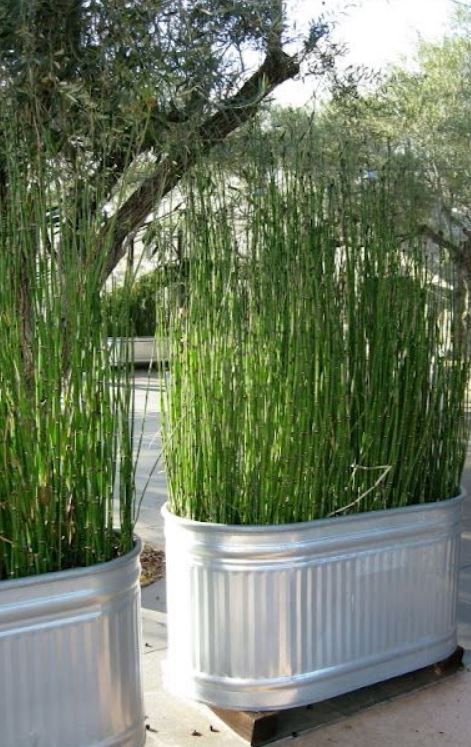
You can use oversized planters filled with tall ornamental grasses to create a simple and natural privacy wall. This option works well on patios, decks, or porches where you may not want to install a fence.
Choose grasses like pampas, fountain, or feather reed grass for their height and movement. These plants grow upright and fill in quickly, giving you a soft screen that blocks views without feeling heavy.
Planters in neutral or metallic finishes blend easily with modern or traditional outdoor spaces. By arranging them in a row, you can form a clear boundary while still keeping the area open and airy.
Tall grass planters also let you move or rearrange your privacy screen as needed. This flexibility makes them a practical choice if you want seasonal changes or need to adjust your layout.
Privacy Trellis with Vines
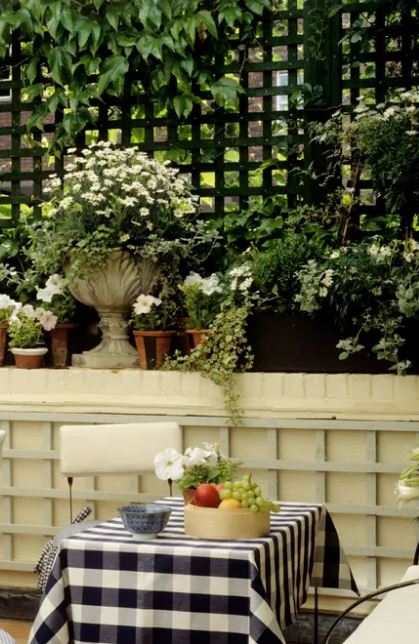
A trellis with climbing plants gives you a natural way to block views while keeping your patio open and inviting. You can place it along a fence, beside a seating area, or as a divider between spaces. The structure adds height and greenery without taking up much ground space.
When you train vines like ivy, jasmine, or clematis to grow on the trellis, they create a living screen. Ivy grows quickly and provides dense coverage, while jasmine adds fragrance. Clematis offers colorful flowers during the growing season.
You can choose wood, metal, or vinyl trellises depending on your climate and style preference. Wood gives a classic look, while vinyl resists moisture better in wet areas. Metal works well for a modern design and supports heavier vines.
Position the trellis where it receives enough sunlight for the plants you select. Regular pruning keeps the vines healthy and encourages fuller growth. With time, the trellis becomes a green wall that softens the space and increases privacy.
Hanging Planter Curtain
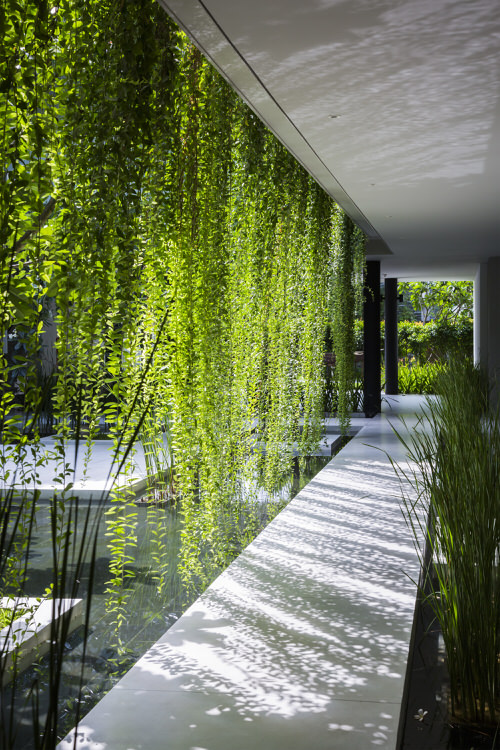
You can create a simple privacy screen by hanging rows of small potted plants from a frame, pergola, or balcony railing. This setup works well in tight spaces because it uses vertical space instead of floor area.
Choose lightweight pots or baskets and secure them with sturdy hooks or chains. Herbs, trailing vines, or flowering plants all work well and give you both greenery and coverage.
By arranging the planters in rows, you form a curtain that blocks direct views while still letting in light and air. The plants soften the look of the space and make it feel more inviting.
This approach also gives you flexibility. You can swap out seasonal plants, adjust the spacing for more or less coverage, and even grow edible herbs for cooking.
Vertical Garden Wall
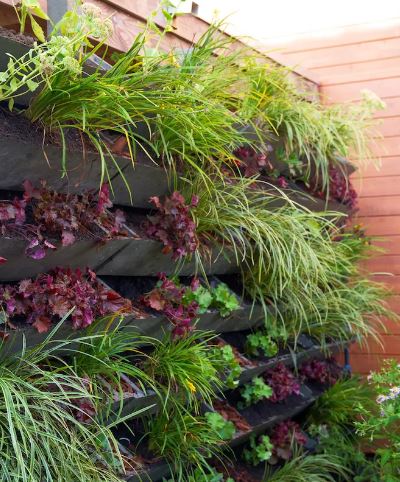
You can use a vertical garden wall to add privacy while bringing more plants into your space. By arranging stacked planters or wall-mounted pockets, you create a natural screen that blocks views and softens hard surfaces.
This type of setup works well for small patios where floor space is limited. You can grow herbs, flowers, or even small vegetables in the pockets, making the wall both functional and attractive.
Wall-mounted planters let you adjust the height and spacing to fit your needs. Stacked planter systems create layers of greenery that cover more surface area and provide extra privacy.
Choosing a mix of plants adds variety and helps the wall look full. Hardy herbs like rosemary or thyme grow well in pockets, while colorful flowers bring visual interest. With regular care, your vertical garden wall can stay healthy and provide lasting coverage.
Tiered Plant Stand Privacy Wall
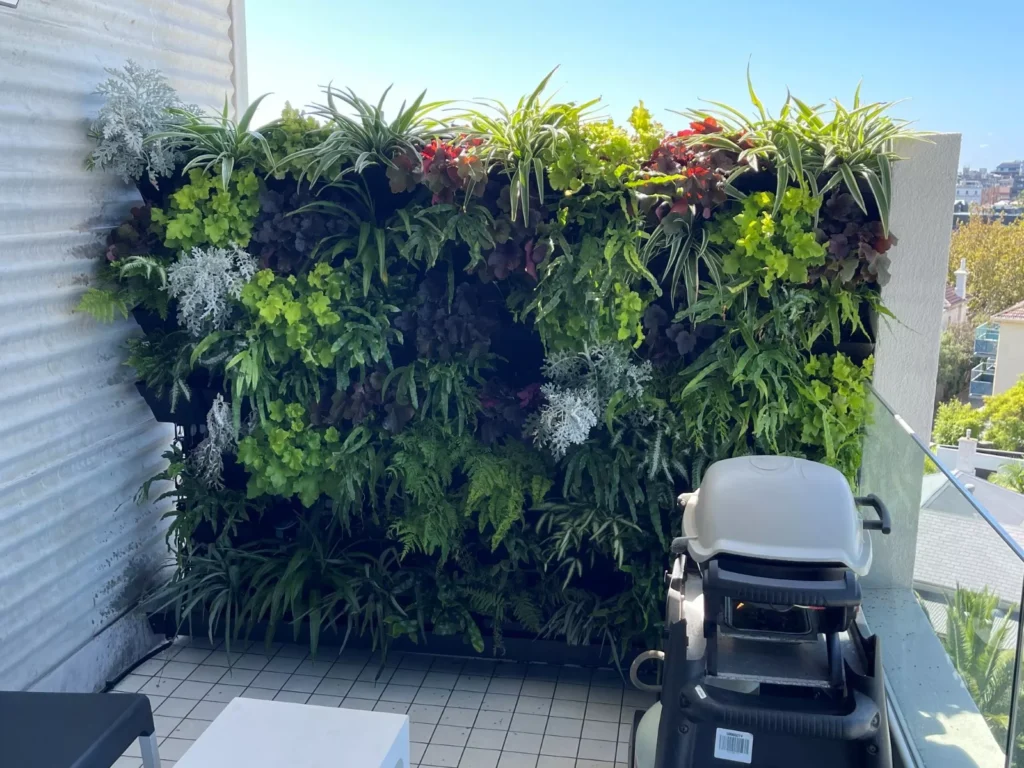
You can use a tiered plant stand to create a simple and effective privacy wall on your patio. The layered design gives you space to arrange multiple pots at different heights, which helps block views while adding greenery.
Choose sturdy wooden, metal, or repurposed ladder-style stands that can hold several plants. Position the stand along the edge of your patio where you want more coverage.
Fill the tiers with leafy plants, tall grasses, or flowering pots to create a natural screen. Mixing plant types adds variety while still providing the barrier you need.
For extra height, place climbing plants in pots at the bottom and let them grow upward with the support of a trellis or frame. This adds more coverage without taking up extra floor space.
You can also move or rearrange the stand as needed since it is not a permanent structure. This flexibility makes it easy to adjust your privacy wall to fit different seasons or gatherings.
Raised Planter Bench with Back Panel

A raised planter bench with a back panel gives you both seating and privacy in one design. You can sit comfortably while the tall panel behind you blocks views and reduces distractions. This setup works well in small patios or decks where space is limited.
You can build the bench with a sturdy wooden frame and attach planter boxes at the base. The planters provide room for flowers, shrubs, or climbing plants. As the plants grow, they fill in the back panel and create a natural screen.
Using a lattice or slatted panel behind the bench makes it easy for vines to climb. This adds height and greenery without taking up much floor space. You gain shade and privacy while also softening the look of your outdoor area.
You can place the bench along a fence, wall, or open edge of your patio. This makes it flexible for different layouts and styles. By choosing plants that match your climate, you can keep the screen low-maintenance and long-lasting.
Clever DIY Projects
You can build privacy into your patio with simple do-it-yourself projects that use everyday materials. These projects let you adjust the look and function of your space without major construction.
A pallet wood screen is an easy option. You can stack or arrange pallets vertically, then paint or stain them to match your style. Adding small planters to the gaps gives you both greenery and privacy.
Fabric panels work well if you want something lightweight. You can hang outdoor curtains from a rod, pergola, or wire. This lets you slide them open or closed depending on how much coverage you want.
Lattice panels are another versatile choice. You can install them as freestanding screens or attach them to existing fences. Training climbing plants on the lattice adds natural shade and more seclusion.
Here are a few quick comparisons:
| Project Type | Materials Needed | Difficulty | Extra Benefit |
|---|---|---|---|
| Pallet Screen | Pallets, paint, planters | Easy | Built-in planter space |
| Fabric Panels | Outdoor fabric, rod/wire | Easy | Flexible coverage |
| Lattice Panels | Lattice sheets, posts | Moderate | Supports climbing plants |
If you prefer a modern look, you can use metal panels with cut-out designs. These provide privacy while letting some light filter through.
Repurposing old doors, shutters, or even bamboo poles can also give you a low-cost and unique screen. Each option can be customized with paint, stain, or plants to fit your patio.
DIY Pallet Wall
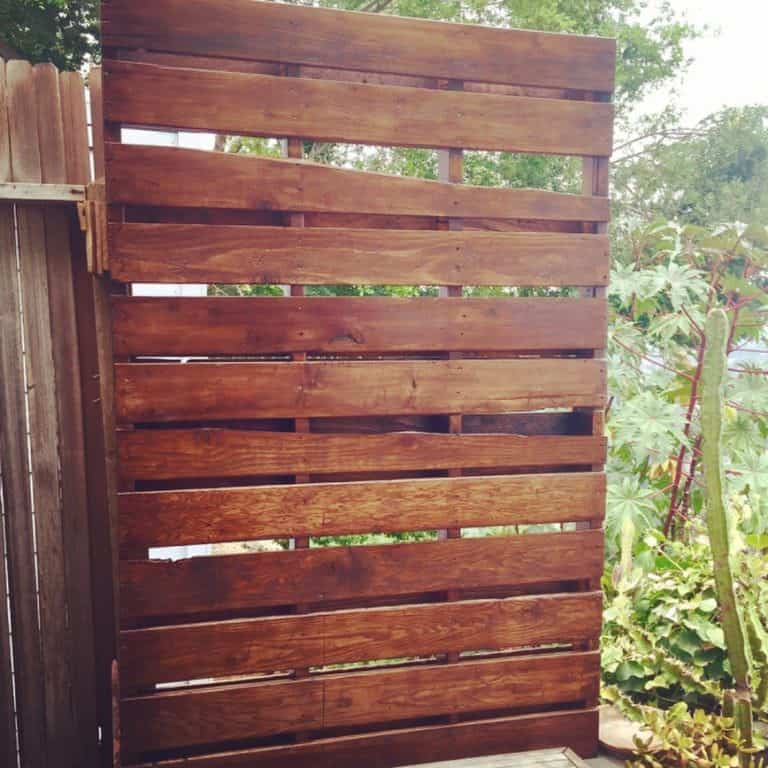
A pallet wall gives you a simple and low-cost way to add privacy to your patio. You can often find pallets for free from warehouses or buy them at home improvement stores. Sand the wood to remove rough edges before you begin building.
You can stack pallets vertically or horizontally, depending on the height and look you want. Secure them with screws or brackets for stability. If you prefer a more finished appearance, add a wooden frame around the edges.
Personalize your pallet wall with paint or stain to match your outdoor space. A light coat of weatherproof sealant also helps protect the wood from rain and sun.
You can make the wall more functional by attaching shelves or hooks. Hanging planters fit well between the slats and let you grow flowers, herbs, or small vegetables. This adds color and greenery while keeping your patio private.
With a little effort, your pallet wall can serve as both a screen and a decorative feature. It provides privacy while giving you room to display plants or outdoor décor in a way that feels custom and practical.
DIY Macramé Privacy Screen
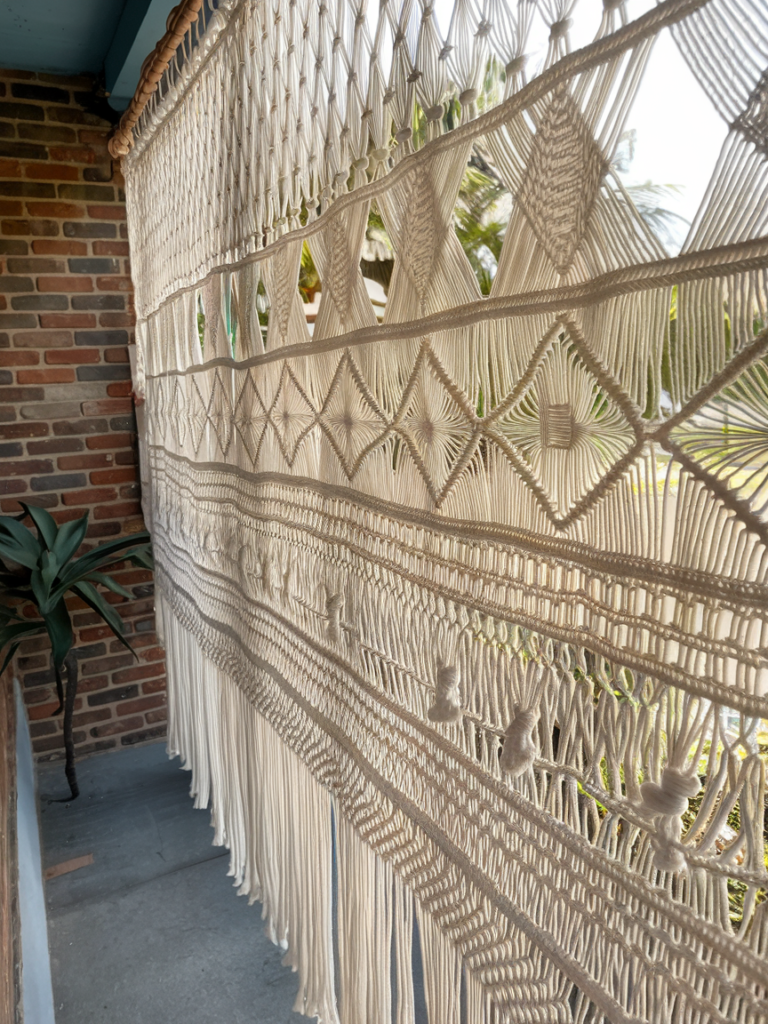
You can create a macramé privacy screen using sturdy rope or cord, which adds both function and style to your patio. The woven design provides partial coverage while letting in light and air. This makes it a good choice if you want privacy without blocking the open feel of your space.
Start by choosing a strong cord, such as cotton or nylon, that can handle outdoor use. Attach the cords to a wooden frame, dowel, or metal rod. Then use simple knots like square knots or half hitches to build your pattern.
You have the freedom to keep the design simple or try more detailed knotting for extra texture. A tighter weave gives more privacy, while a looser weave creates a light, airy look. You can also adjust the size of the panel to fit your patio or balcony.
Adding natural wood, driftwood, or painted rods as supports can give your screen a finished look. If you want more color, you can dye the cord or mix in different rope thicknesses. This project works well as a weekend DIY and brings a handmade touch to your outdoor space.
Recycled Window Shutter Wall
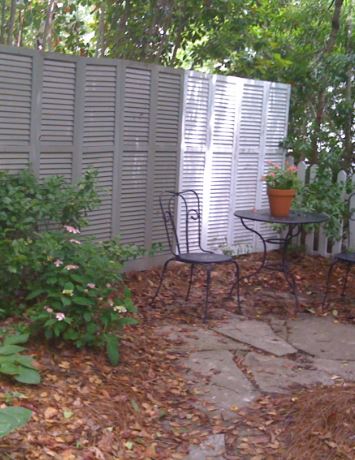
You can turn old wooden shutters into a simple and effective privacy wall for your patio or balcony. By standing them side by side, you create a screen that blocks views while still letting in light and air.
Painting the shutters gives you control over the look. Bright colors add a playful touch, while muted tones create a softer, rustic style. You can even mix shades for a more eclectic design.
This project works well if you want something affordable and unique. Salvage yards, flea markets, or even your own storage shed are good places to find shutters. With a few hinges or brackets, you can connect them into a sturdy wall.
Adding plants or hanging decorations to the shutters can make the space feel even more personal. The shutters provide both function and character, turning your outdoor area into a private and comfortable spot.
Cedar Privacy Wall with Shelves
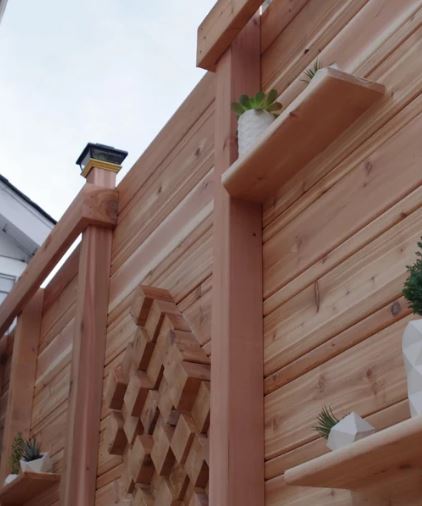
A cedar privacy wall gives you a solid barrier while adding warmth to your patio. Cedar resists decay and holds up well outdoors, making it a practical choice for long-term use.
You can build the wall with horizontal or vertical slats, leaving small gaps if you want light and airflow. The design stays simple, but it looks clean and modern.
Adding shelves to the structure increases its function. You can place potted plants, lanterns, or small décor items on the shelves to bring life to the wall.
The shelves also break up the flat surface, making the wall feel less heavy. This approach works well in small patios where you want both privacy and storage.
With a few basic tools, screws, and cedar boards, you can build a wall that fits your space. The natural wood tone blends with most outdoor styles, and you can leave it unfinished or apply a sealant to keep the color longer.
Lattice Fence with String Lights
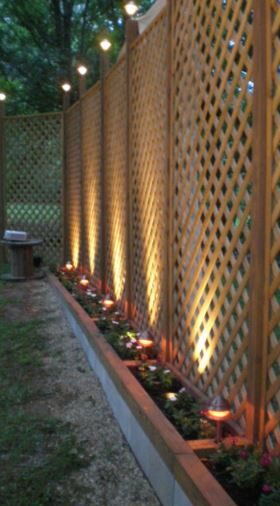
A lattice fence gives your patio a balance of privacy and openness. The crisscross pattern blocks direct views while still letting in air and natural light. Adding one along the edge of your patio creates a defined boundary without making the space feel closed in.
You can weave string lights through the lattice to make the area more inviting after sunset. The small gaps in the design hold lights securely and spread them evenly across the surface. This setup provides soft illumination that works well for relaxing or hosting guests.
Choose weather-resistant string lights to handle outdoor conditions. Solar or LED options reduce energy use and require little maintenance. By combining the fence with lighting, you create a feature that is both practical during the day and functional at night.
This approach works in small or large patios because the lattice can be cut or extended to fit. The lights add character without overwhelming the structure. With simple installation, you can improve privacy and atmosphere at the same time.
Modern Design Fixes
You can give your patio a clean and updated look with simple modern design choices. These fixes focus on sleek lines, neutral colors, and multipurpose elements that blend style with function.
One option is to install metal or composite privacy screens. They last longer than wood, need less upkeep, and often come in geometric cutout patterns that add visual interest.
Another idea is to use shade sails. They provide coverage from the sun while also creating a sense of enclosure. Choose solid colors like gray, white, or black for a modern touch.
Glass panels are another choice if you want privacy without blocking light. Frosted or tinted glass works well for separating spaces while keeping a bright, open feel.
You can also mix concrete planters with tall greenery. This pairs natural elements with modern materials, giving you both privacy and a structured design.
| Modern Fix | Key Benefit |
|---|---|
| Metal screens | Low maintenance, stylish patterns |
| Shade sails | Sun protection and privacy |
| Frosted glass panels | Light control with separation |
| Concrete planters | Combines plants with structure |
Using a few of these updates helps you create a patio that feels private but also looks current and uncluttered.
Laser-Cut Metal Privacy Screens
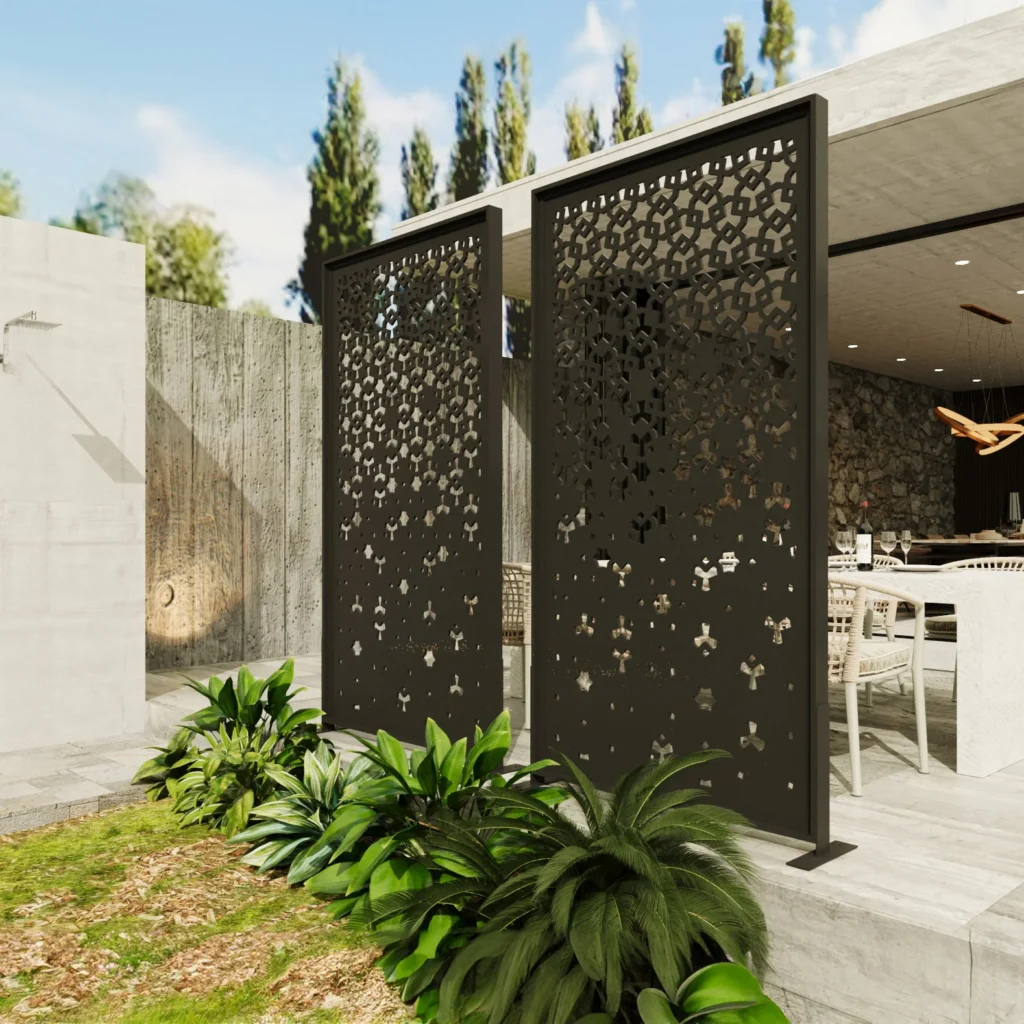
You can use laser-cut metal privacy screens to add both function and style to your patio. These panels create a physical barrier that helps block unwanted views while still letting light and air pass through.
The designs often feature geometric or floral patterns cut directly into the metal. This makes the screen feel more like a piece of art than a plain divider.
You can place these screens along the edge of a deck, balcony, or garden area. They work well as stand-alone panels or mounted in front of existing walls for extra detail.
Because they are made from durable materials like steel or aluminum, they hold up well outdoors. Many are also powder-coated to resist rust and fading.
At night, you can highlight the patterns with simple lighting. This adds a subtle design element while keeping the space private.
Pergola with Side Panels
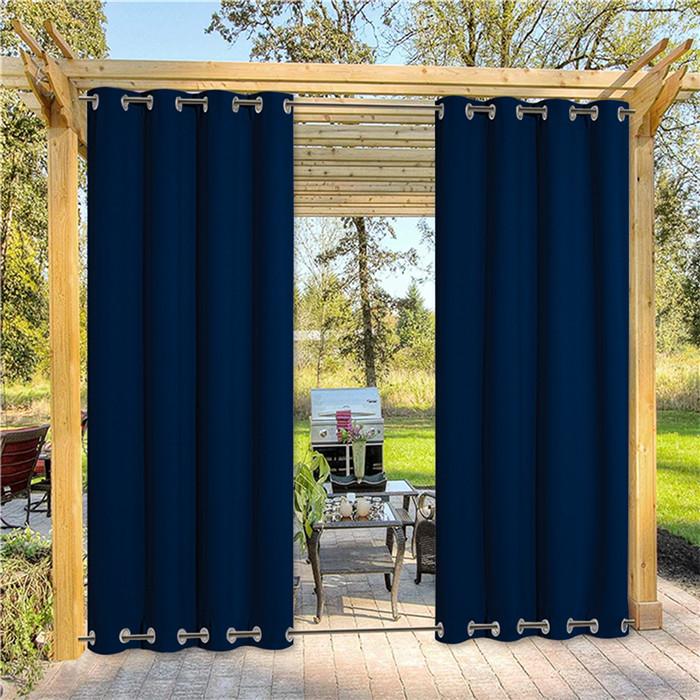
You can turn a basic pergola into a more private space by adding side panels. These panels act as barriers, giving you shade and blocking unwanted views from neighbors or nearby streets.
Choose from different panel styles depending on your needs. Solid panels provide the most coverage, while slatted or lattice panels let in light and airflow but still limit visibility.
If you prefer a softer look, you can use climbing vines on lattice panels. Plants like ivy or jasmine grow well on these surfaces and add greenery while increasing privacy.
Side panels also help define the space under your pergola. They create a clear boundary, making the area feel more like an outdoor room where you can relax without distractions.
Retractable Fabric Shade Walls
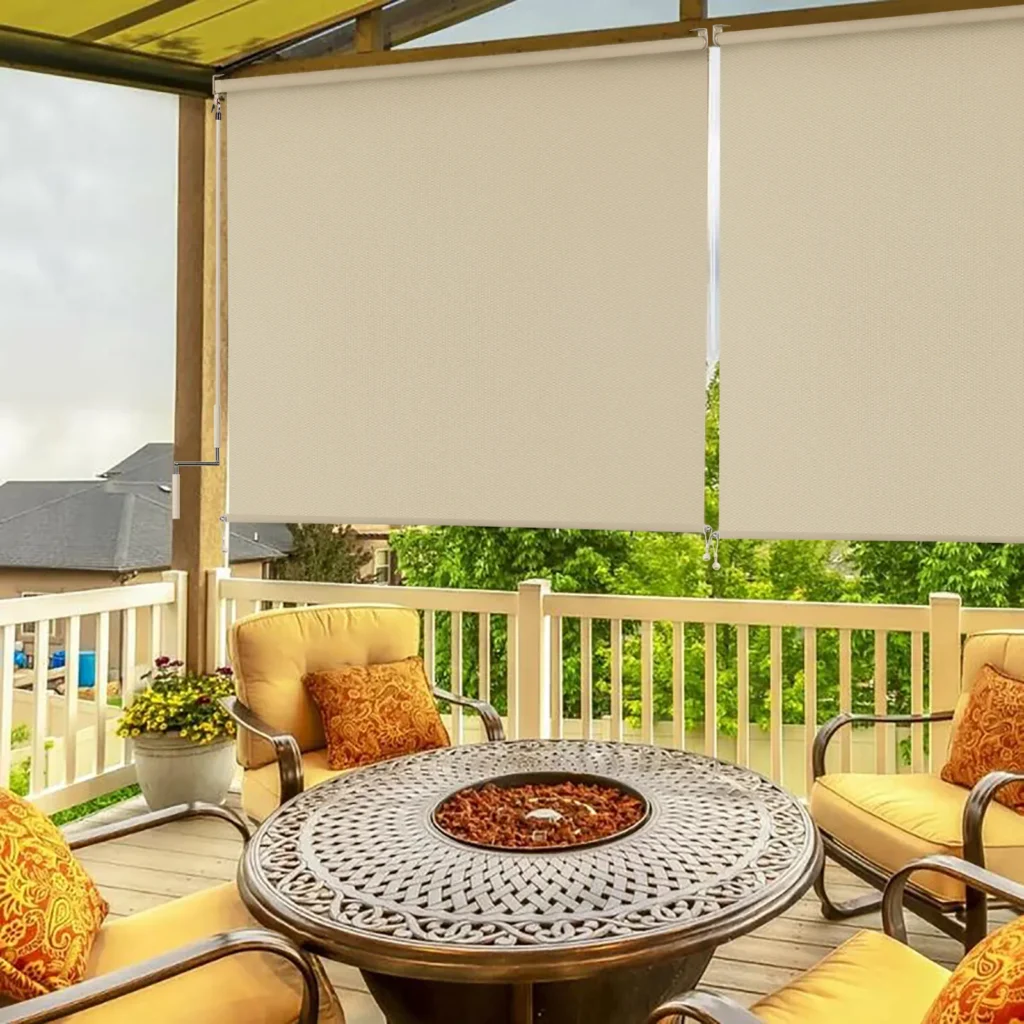
Retractable fabric shade walls give you the option to create privacy only when you need it. You can roll them down like outdoor blinds to block views and sunlight, then retract them to open up your space again.
These shades work well on patios, decks, or pergolas. You can mount them to existing structures, making them a flexible choice without major changes to your layout.
Fabric options range from light-filtering materials to heavier textiles that provide more coverage. This lets you control how much light and privacy you want at different times of the day.
The clean, simple design of retractable shade walls fits modern outdoor spaces. They add function without taking away from the look of your patio.
With regular care, such as cleaning the fabric and checking the hardware, these shades can last for years. You can enjoy a private, shaded space while still keeping the option for open views whenever you choose.
Hanging Outdoor Curtains
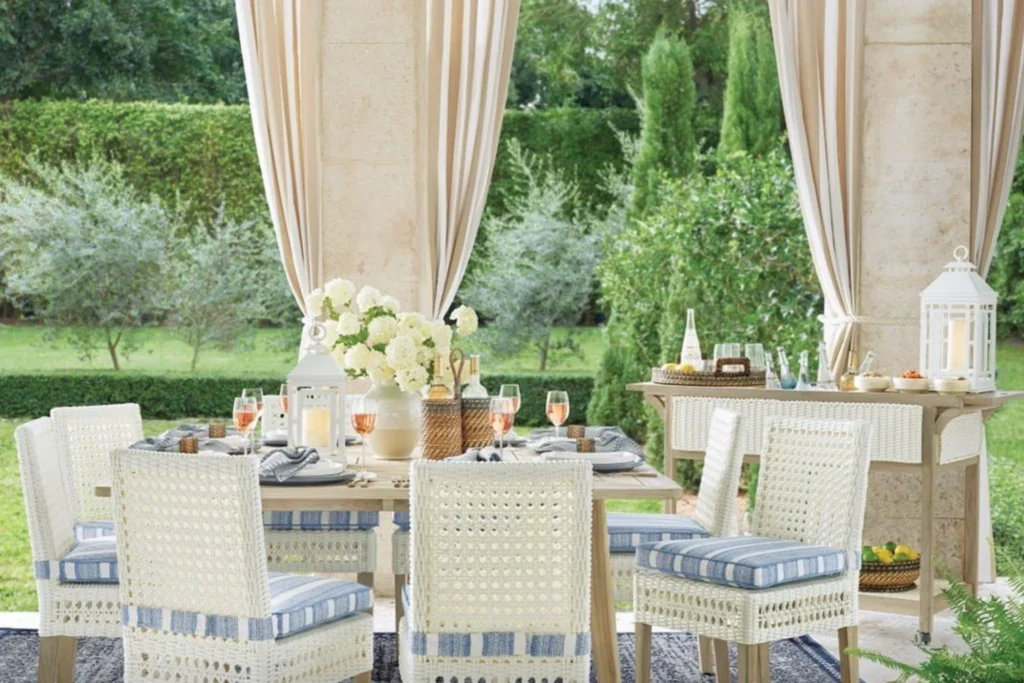
You can use outdoor curtains to add privacy and shade to your patio. Weatherproof fabrics hold up well against sun, wind, and rain, making them practical for year-round use. Choose neutral or light colors if you want a softer look, or darker shades for more coverage.
A pergola makes a good frame for hanging curtains. You can mount rods or use hooks to secure panels along the beams. This setup creates a flexible wall that you can open or close depending on the time of day.
If you don’t have a pergola, you can attach curtains to deck railings or posts. Tension rods also work well between sturdy supports, especially in smaller spaces. This option lets you create privacy without permanent construction.
Outdoor curtains can also help block direct sun and reduce glare. When drawn, they create a calm, enclosed space that feels more comfortable for relaxing or dining. You can pull them back to enjoy the view when you want more openness.
Regular cleaning and proper storage will extend the life of your curtains. Make sure they are dry before putting them away to prevent mildew. With simple care, they can stay functional and attractive for many seasons.
Modern Slatted Wood Divider
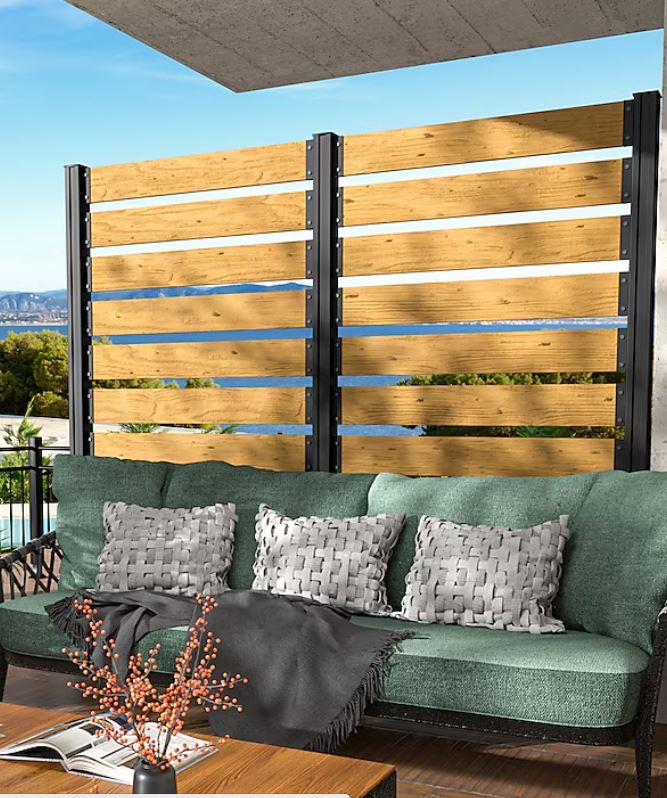
A modern slatted wood divider gives your patio privacy without making the space feel closed off. The gaps between the slats let in natural light and allow air to flow, so your area stays bright and comfortable.
You can choose horizontal or vertical slats depending on the look you prefer. Horizontal lines create a wider, more open feel, while vertical slats can make the space look taller. Both styles keep the design clean and simple.
The spacing between slats controls how much privacy you get. Narrow gaps block more views, while wider gaps allow more visibility. This makes it easy to adjust the balance between openness and seclusion.
Slatted dividers work well with many patio styles. You can stain the wood for a natural finish, paint it for a modern touch, or leave it untreated for a rustic look. This flexibility makes it easy to match your existing outdoor design.
Because the structure is straightforward, you can install a slatted divider as a freestanding panel or attach it to an existing fence or wall. This gives you options for both small and large patios.
Gabion Rock Wall
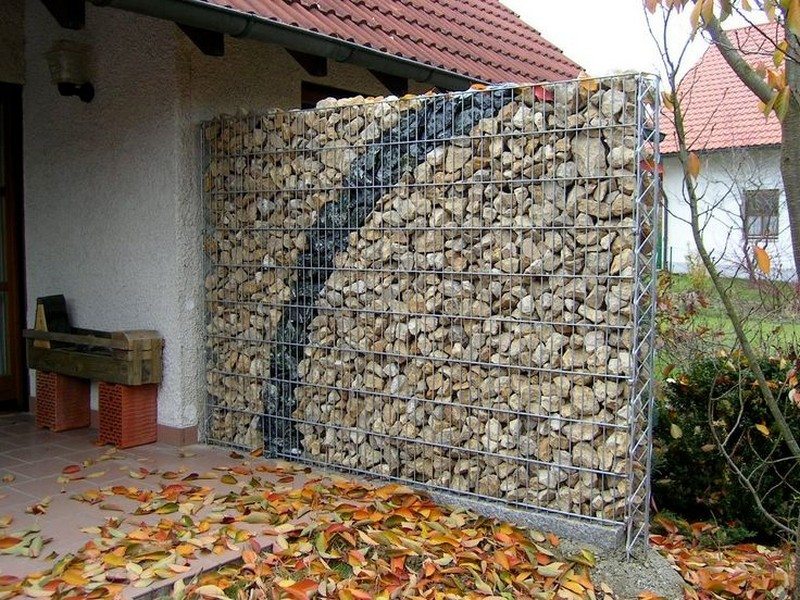
A gabion wall uses wire cages filled with rocks to form a sturdy structure. You can place these walls around your patio to create privacy while still keeping a natural look. The stones add texture and blend well with outdoor landscapes.
You can choose different types of rock to match your style. Large river stones give a softer appearance, while angular stones create a sharper, modern look. Mixing sizes and colors can also add more visual interest.
Gabion walls work well because they are both functional and decorative. The open design allows water to drain through, which reduces pressure on the structure. This makes them a practical choice for areas with heavy rainfall.
You can build a gabion wall to any height you need for privacy. A low wall can define the edge of your patio, while a taller one can block views from neighbors. The modular design also makes it easier to adjust or expand later.
With the right placement, a gabion wall can serve as both a screen and a backdrop. It creates a private space without feeling closed in, giving your patio a modern yet natural boundary.
Frosted Glass Panels
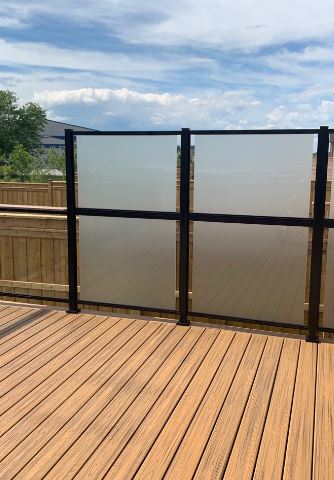
Frosted glass panels give your patio or balcony a clean, modern look while adding privacy. The glass obscures direct views but still allows light to pass through, keeping your space bright and open.
You can install these panels as part of a railing system or as stand-alone screens. They work well in smaller areas where solid walls might feel heavy or block too much daylight.
If you want a more custom look, you can order panels in specific sizes or styles. Some options include tinted glass, which reduces glare and adds a subtle color tone.
Installation can be done with railing kits, mounting posts, or weather-resistant adhesives, depending on your setup. Choosing the right method ensures the panels stay secure outdoors.
By using frosted or tinted glass, you add an architectural element that feels upscale and permanent. This choice blends function with design, making your outdoor area feel like a natural extension of your home.
Movable Privacy Screens
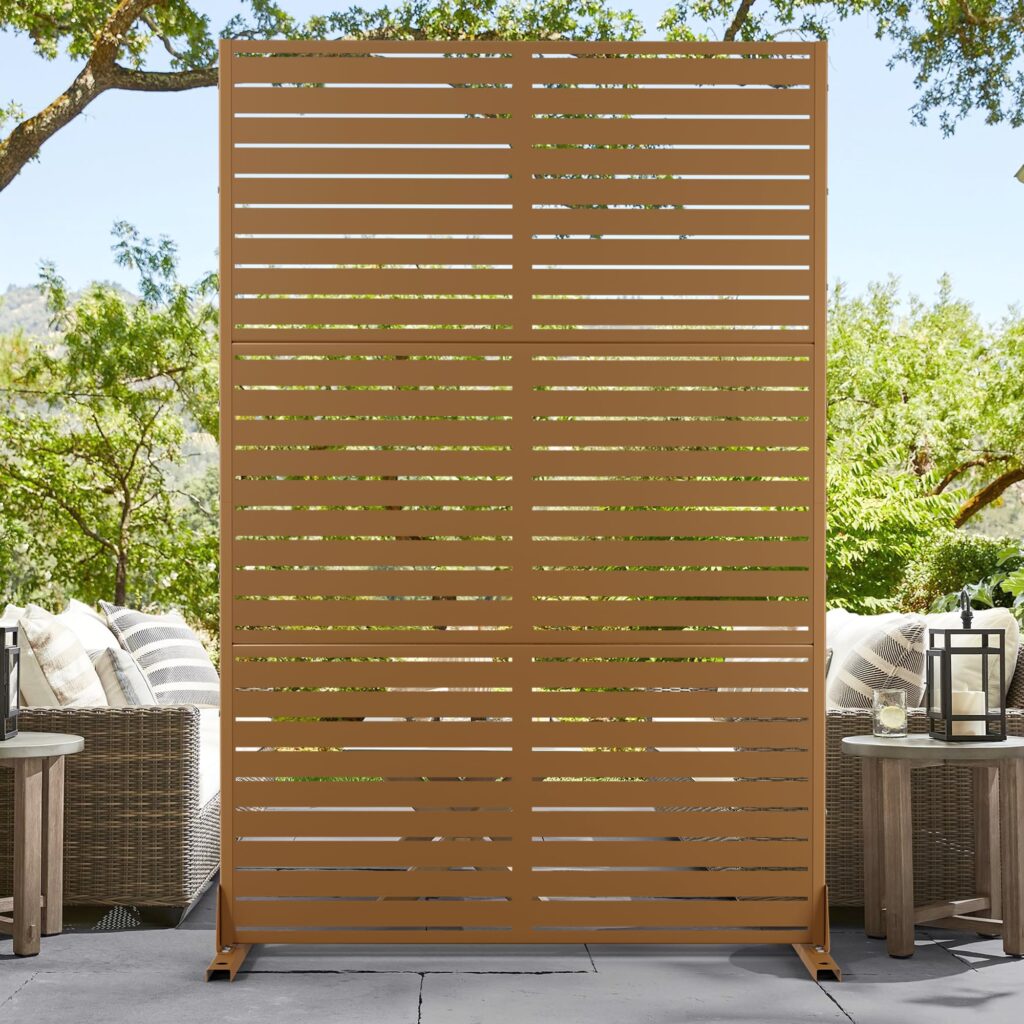
Movable privacy screens give you flexibility in how you use your patio. You can place them where you need coverage and shift them as your seating or sun changes. This makes them useful for both small and large outdoor spaces.
Many freestanding screens fold, so you can store them away when not in use. This helps if you only want privacy at certain times or if you need to free up space for gatherings. Folding designs also make them easier to move between different areas of your yard.
You can find movable screens in wood, metal, or fabric. Wood panels add a natural look, while fabric options feel lighter and easier to handle. Metal frames offer durability and often come in modern styles that fit well with contemporary patios.
Some screens include planter bases or decorative panels. These add both function and style, giving you privacy while also enhancing the look of your outdoor area. By choosing a movable screen, you can adjust your setup without committing to a permanent structure.
Accordion Folding Divider
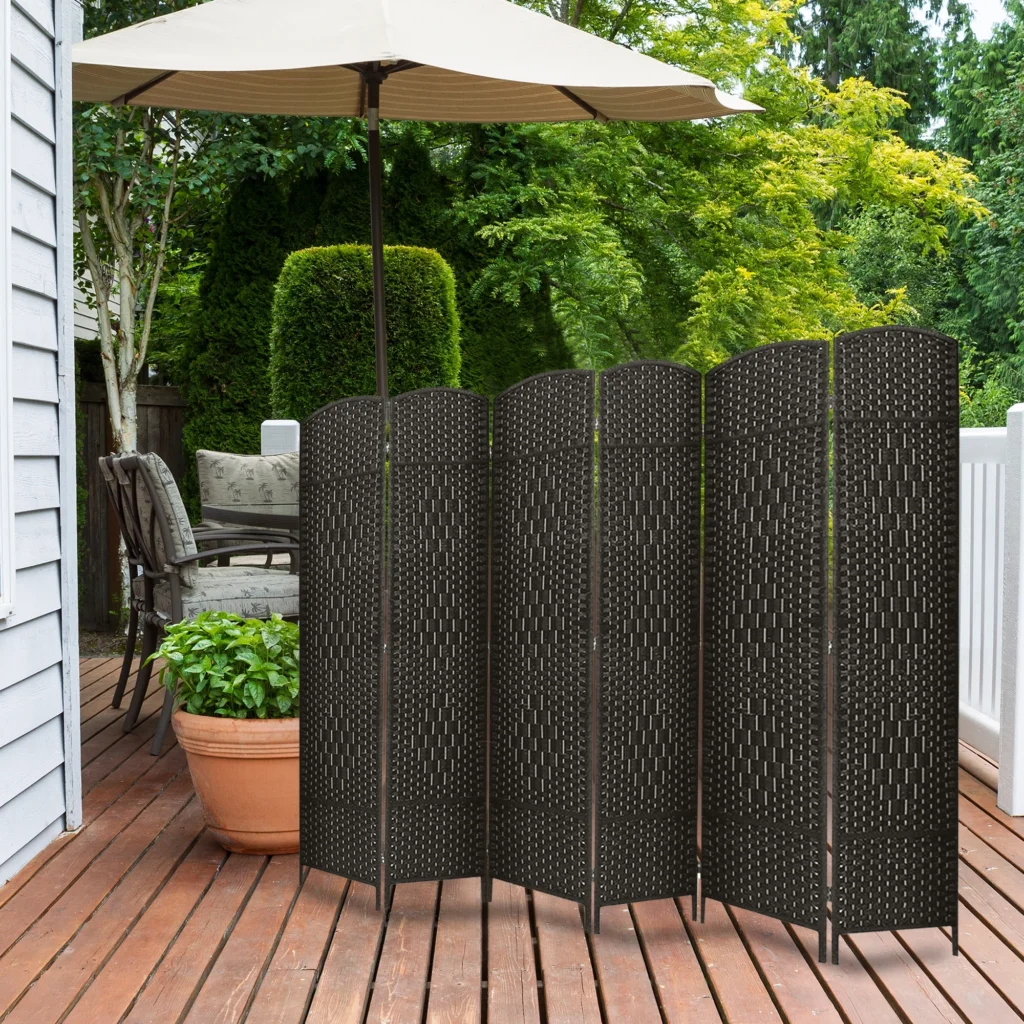
An accordion folding divider gives you flexible control over your outdoor privacy. You can expand it when you want more coverage and fold it back when you prefer an open view. This makes it a practical choice for patios that serve different purposes throughout the day.
You can find dividers made from wood, metal, or weather-resistant fabric. Many designs are lightweight, so you can move them around your space without much effort. Some models even come with wheels for easier setup and storage.
These dividers work well in small patios or balconies where permanent walls are not an option. You can place them along one side for partial coverage or stretch them across a wider area to block views.
Because they fold flat, you can store them away during the off-season or when you want a more open layout. This makes them a space-saving option compared to fixed panels or fencing.
With the right material and finish, an accordion divider can also add style to your outdoor area. Whether you prefer a natural wood look or a modern metal frame, you can choose a design that matches your patio furniture and décor.
Benefits of Patio Privacy Solutions
Adding privacy to your patio helps you enjoy your outdoor space with fewer distractions. It can also make your property more practical, appealing, and secure.
Enhanced Comfort and Relaxation
When you block unwanted views, you create a more peaceful setting. A private patio lets you enjoy meals, reading, or conversations without feeling watched. This makes your outdoor area feel like an extension of your home rather than a public space.
You also reduce noise and visual clutter. Tall plants, fences, or screens can soften sounds from neighbors or streets, making it easier to relax.
Examples of comfort-focused options:
- Outdoor curtains for shade and seclusion
- Tall greenery for natural screening
- Lattice panels to filter light while keeping privacy
By combining these elements, you can enjoy a calm and inviting space that feels personal and comfortable.
Increased Property Value
Well-designed privacy features often add to your home’s market appeal. Buyers tend to see a private outdoor area as a usable living space, not just a yard. This can make your property stand out compared to homes without these improvements.
Materials and design matter. A simple wooden fence may improve function, but a decorative screen or landscaped border can also enhance curb appeal. Both practical and aesthetic upgrades can influence how buyers view your home.
Ways privacy upgrades add value:
- Expanded living space outdoors
- Low-maintenance landscaping that doubles as screening
- Attractive fencing that complements the home’s style
These details can make your patio feel like a purposeful part of the property, which may increase its resale value.
Improved Security
Patio privacy solutions also help protect your home. Barriers like fences, hedges, or trellises can make it harder for intruders to see inside or access your property. Even simple screens reduce visibility into your yard, lowering the chance of unwanted attention.
Lighting and layout play a role too. Pairing a privacy fence with motion lights or dense shrubs with a clear entry path can increase both safety and comfort.
Security benefits include:
- Reduced visibility into your home and yard
- Physical barriers that slow access
- Greater sense of control over your space
With the right setup, you can enjoy your patio while also feeling more secure in your property.
Design Considerations for Patio Privacy
When planning a private patio, you need to think about how long your materials will last, how well your design fits with your yard, and how much light you want to keep. Each choice affects comfort, upkeep, and the way your outdoor space feels day to day.
Choosing Materials for Durability
The right material helps your privacy feature last through weather changes and regular use. Wood offers a natural look but needs sealing or staining to resist rot and insects. Composite boards or vinyl panels require less upkeep and hold color longer.
For metal options, aluminum resists rust and is lightweight, while steel offers strength but may need protective coatings. Stone or brick walls provide lasting privacy but cost more and require professional installation.
A quick comparison:
| Material | Maintenance | Lifespan | Cost Level |
|---|---|---|---|
| Wood | High | Medium | $$ |
| Composite | Low | Long | $$$ |
| Metal | Medium | Long | $$-$$$ |
| Stone/Brick | Low | Very Long | $$$$ |
Choose based on climate, budget, and how much time you want to spend on maintenance.
Blending Privacy Features With Landscaping
You can soften the look of fences, screens, or walls by combining them with plants. Tall shrubs, bamboo, or climbing vines create a layered effect that feels more natural. This approach reduces the harsh lines of solid barriers.
Mixing greenery with hard structures also improves airflow and gives your yard more texture. For example, a lattice panel with ivy offers both coverage and visual interest.
Think about plant growth speed and upkeep. Fast growers like bamboo fill space quickly but may spread aggressively. Slower shrubs take longer but require less control. Matching plant types to your space keeps the design balanced and manageable.
Maximizing Natural Light
Privacy features should block views without leaving your patio dark or closed in. Slatted screens, lattice panels, or pergolas with fabric allow filtered light while still creating separation.
If you use tall plants, place them where they block sightlines but not direct sunlight. For small patios, consider lighter-colored materials that reflect light instead of absorbing it.
Outdoor curtains are another option. They can be tied back to let in sun during the day and drawn for privacy at night. Balancing light and coverage makes the space feel both private and open.
Related articles about outdoor privacy:
Hide in Plain Site: Creative Patio Privacy Walls, Screens and More
From Tiny Balconies to Big Decks: Privacy Hacks for Every Space
Designer Fixes for Deck and Patio Privacy that Actually Work


